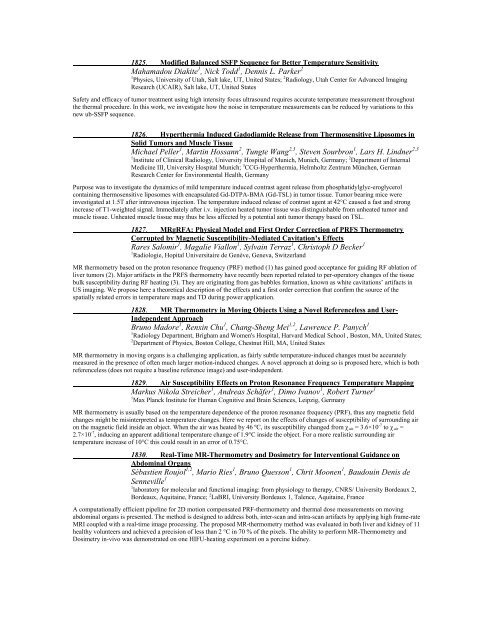Traditional Posters: Interventional - ismrm
Traditional Posters: Interventional - ismrm
Traditional Posters: Interventional - ismrm
You also want an ePaper? Increase the reach of your titles
YUMPU automatically turns print PDFs into web optimized ePapers that Google loves.
1825. Modified Balanced SSFP Sequence for Better Temperature Sensitivity<br />
Mahamadou Diakite 1 , Nick Todd 1 , Dennis L. Parker 2<br />
1 Physics, University of Utah, Salt lake, UT, United States; 2 Radiology, Utah Center for Advanced Imaging<br />
Research (UCAIR), Salt lake, UT, United States<br />
Safety and efficacy of tumor treatment using high intensity focus ultrasound requires accurate temperature measurement throughout<br />
the thermal procedure. In this work, we investigate how the noise in temperature measurements can be reduced by variations to this<br />
new ub-SSFP sequence.<br />
1826. Hyperthermia Induced Gadodiamide Release from Thermosensitive Liposomes in<br />
Solid Tumors and Muscle Tissue<br />
Michael Peller 1 , Martin Hossann 2 , Tungte Wang 2,3 , Steven Sourbron 1 , Lars H. Lindner 2,3<br />
1 Institute of Clinical Radiology, University Hospital of Munich, Munich, Germany; 2 Department of Internal<br />
Medicine III, University Hospital Munich; 3 CCG-Hyperthermia, Helmholtz Zentrum München, German<br />
Research Center for Environmental Health, Germany<br />
Purpose was to investigate the dynamics of mild temperature induced contrast agent release from phosphatidylglyc-eroglycerol<br />
containing thermosensitive liposomes with encapsulated Gd-DTPA-BMA (Gd-TSL) in tumor tissue. Tumor bearing mice were<br />
investigated at 1.5T after intravenous injection. The temperature induced release of contrast agent at 42°C caused a fast and strong<br />
increase of T1-weighted signal. Immediately after i.v. injection heated tumor tissue was distinguishable from unheated tumor and<br />
muscle tissue. Unheated muscle tissue may thus be less affected by a potential anti tumor therapy based on TSL.<br />
1827. MRgRFA: Physical Model and First Order Correction of PRFS Thermometry<br />
Corrupted by Magnetic Susceptibility-Mediated Cavitation’s Effects<br />
Rares Salomir 1 , Magalie Viallon 1 , Sylvain Terraz 1 , Christoph D Becker 1<br />
1 Radiologie, Hopital Universitaire de Genève, Geneva, Switzerland<br />
MR thermometry based on the proton resonance frequency (PRF) method (1) has gained good acceptance for guiding RF ablation of<br />
liver tumors (2). Major artifacts in the PRFS thermometry have recently been reported related to per-operatory changes of the tissue<br />
bulk susceptibility during RF heating (3). They are originating from gas bubbles formation, known as white cavitations’ artifacts in<br />
US imaging. We propose here a theoretical description of the effects and a first order correction that confirm the source of the<br />
spatially related errors in temperature maps and TD during power application.<br />
1828. MR Thermometry in Moving Objects Using a Novel Referenceless and User-<br />
Independent Approach<br />
Bruno Madore 1 , Renxin Chu 1 , Chang-Sheng Mei 1,2 , Lawrence P. Panych 1<br />
1 Radiology Department, Brigham and Women's Hospital, Harvard Medical School , Boston, MA, United States;<br />
2 Department of Physics, Boston College, Chestnut Hill, MA, United States<br />
MR thermometry in moving organs is a challenging application, as fairly subtle temperature-induced changes must be accurately<br />
measured in the presence of often much larger motion-induced changes. A novel approach at doing so is proposed here, which is both<br />
referenceless (does not require a baseline reference image) and user-independent.<br />
1829. Air Susceptibility Effects on Proton Resonance Frequency Temperature Mapping<br />
Markus Nikola Streicher 1 , Andreas Schäfer 1 , Dimo Ivanov 1 , Robert Turner 1<br />
1 Max Planck Institute for Human Cognitive and Brain Sciences, Leipzig, Germany<br />
MR thermometry is usually based on the temperature dependence of the proton resonance frequency (PRF), thus any magnetic field<br />
changes might be misinterpreted as temperature changes. Here we report on the effects of changes of susceptibility of surrounding air<br />
on the magnetic field inside an object. When the air was heated by 46 ºC, its susceptibility changed from χ air = 3.6×10 -7 to χ air =<br />
2.7×10 -7 , inducing an apparent additional temperature change of 1.9°C inside the object. For a more realistic surrounding air<br />
temperature increase of 10°C this could result in an error of 0.75°C.<br />
1830. Real-Time MR-Thermometry and Dosimetry for <strong>Interventional</strong> Guidance on<br />
Abdominal Organs<br />
Sébastien Roujol 1,2 , Mario Ries 1 , Bruno Quesson 1 , Chrit Moonen 1 , Baudouin Denis de<br />
Senneville 1<br />
1 laboratory for molecular and functional imaging: from physiology to therapy, CNRS/ University Bordeaux 2,<br />
Bordeaux, Aquitaine, France; 2 LaBRI, University Bordeaux 1, Talence, Aquitaine, France<br />
A computationally efficient pipeline for 2D motion compensated PRF-thermometry and thermal dose measurements on moving<br />
abdominal organs is presented. The method is designed to address both, inter-scan and intra-scan artifacts by applying high frame-rate<br />
MRI coupled with a real-time image processing. The proposed MR-thermometry method was evaluated in both liver and kidney of 11<br />
healthy volunteers and achieved a precision of less than 2 °C in 70 % of the pixels. The ability to perform MR-Thermometry and<br />
Dosimetry in-vivo was demonstrated on one HIFU-heating experiment on a porcine kidney.















